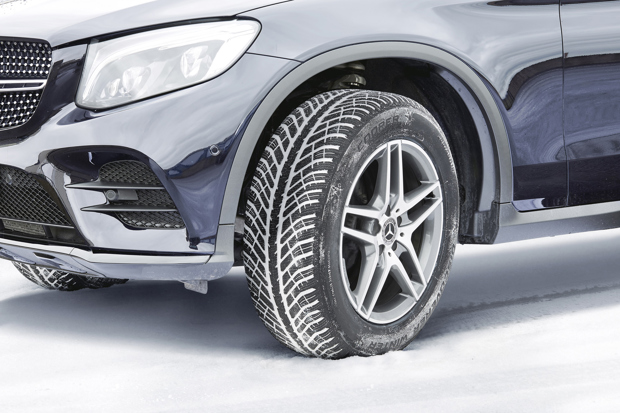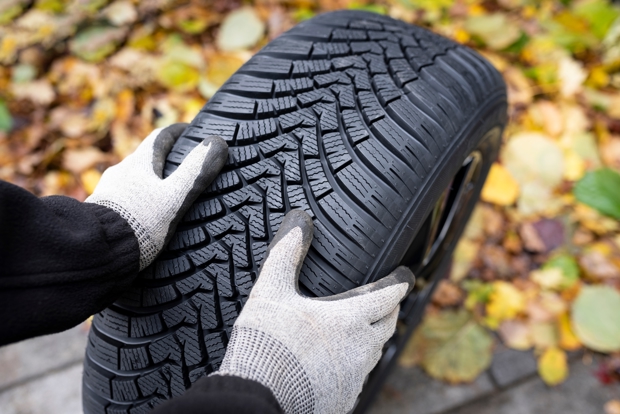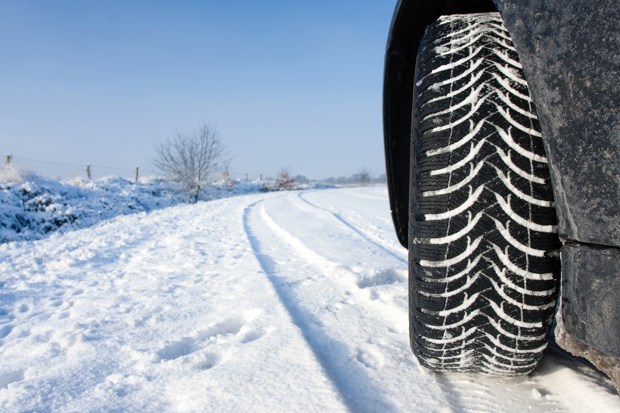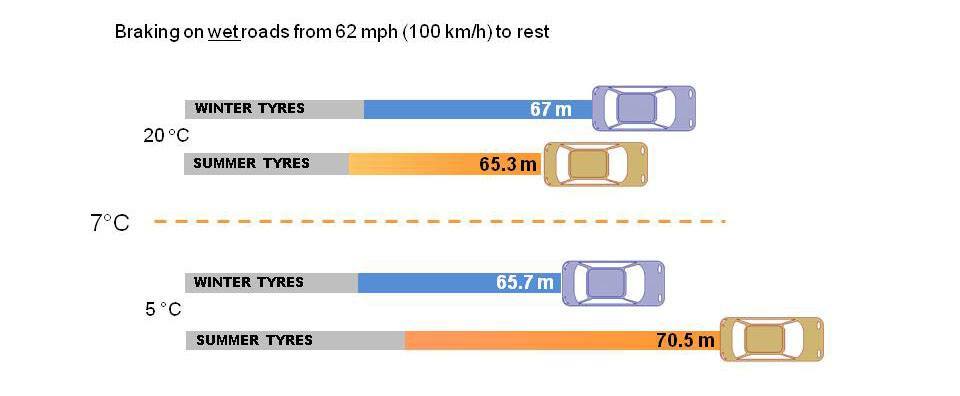Winter tyres: Everything you need to know
What are winter tyres and is it worth buying them? Find out whether they are worthwhile in our complete guide.

- What are winter tyres?
- Find out whether you need winter tyres
- How much do winter tyres cost?
What are winter tyres?
Winter tyres are made from a different compound of rubber that uses more silica and they have extra ‘sipes’ - the tiny grooves that also assist the tyre’s tread to deflect.
This makes the tread blocks softer so they can move around more in low temperature conditions than summer tyres. As a result, winter tyres generate more heat in cold weather and it’s this that gives them more grip on chilly tarmac and icy roads.
Don’t confuse winter tyres with off-road ‘mud and snow’ types, which are aimed at driving in the sort of conditions you would not want to subject the average family car to.
Should I fit winter tyres?
In cold condition where the thermometer reads 7°C or less, winter tyres will help you stop in shorter distances than summer rubber. From 60mph to a stop on a cold, wet road will take 70.5 metres on summer tyres, whereas a car equipped with winters will come to a halt in 65.7 metres.
That’s the length of a large family car and can make the difference between stopping and being involved in a collision. Winter tyres also offer more grip for cornering and pulling away on slippery surfaces, so they give better control when it’s cold.
How do winter tyres work?
By using different compounds to create a softer, more malleable rubber, winter tyres tread patterns can move more in cold conditions than a summer tyre’s. Extra grooves in the tread, called ‘sipes’, also help and the easier movement generates heat.
It’s this warmer tyre temperature that deliver grip and traction when the temperature drops below 7°C. Winter tyres also have a more open tread design that allows them to bite into snow and slush more easily and disperse these chilly road coverings effectively.
You should always fit winter tyres as a set of four. While you might think they will only work on the driven wheels, using only two cold weather tyres can destabilise your car in difficult conditions.
This can cause the car to lose traction and reduce braking just when you need them the most.

How much do winter tyres cost?
As ever, our advice for winter tyres is the same as tyres in general - buy the best that you can afford. Cheap tyres may look appealling, but are often less safe and wear out faseter than those made by the more well-known manufacturers. Price varies of course depending on what size tyre you need.
You'll pay more for an SUV with big wheels - around £250 a tyre for something with 21-inch wheels. At the other end of the scale, for a car with 16-inch wheels you're looking at £125 a tyre. But prices will vary depending on the specific tyre sized needed for your car.
When should I fit winter tyres?
The magic number here is 7C. Once the weather drops below 7C on a consistent basis, that's the time to switch to winter tyres. So when temperatures have been low enough for a few days - and look like staying that way for a while, it's a good time to switch.
What happens when spring arrives?
The first warm day of spring doesn’t mean you have to rush out and change back to summer tyres. They will wear out more quickly in warm weather, but reckon on swapping back to summer tyres in March or April.
Some garages will store your extra set of tyres for a fee (probably not in an actual hotel like above...) or you can take them home and stash the set in the garage. Make sure the tyres are dry and clean, and store up to four stacked upright or on their sides in a dry environment away from direct sunlight.
What about winter tyres in summer?
Winter tyres work at their best at temperatures of 7°C and below and they will wear out at the same rate at summer tyres do in warmer weather. If you leave winter tyres on your car, they can still cope easily with ambient temperatures of 20°C, so you don’t have to worry about a loss of grip or the tyres wearing out rapidly.
Although you have to pay for two sets of tyres, the cost and wear is averaged out over twice the distance one set of tyres will cover, so you spend no more over the course of two or three years.
Will I need another set of wheels if I fit winter tyres?
Some cars with very large alloy wheels and low profile summer tyres will need a second set of wheels for winter tyres. This is because most winter tyres have a taller side profile, so they won’t fit larger types of wheel.
However, smaller wheels are readily available and quite cheap - and they make fitting winter tyres even easier as you don’t have to visit a tyre fitter to have them swapped over. Just make sure the winter wheels have sufficient clearance for the brakes.

Will winter tyres affect my car’s economy and performance?
Even if you fit smaller wheels with winter tyres to your car, the performance and economy should remain the same because the rolling circumference will remain the same.
This is because the winter tyre has a taller side profile that accounts for the difference between a larger alloy wheel and smaller wheel for winter use. The only difference you might notice is a small reduction in cornering grip on winter tyres, but then you should also be driving with added caution in cold conditions to allow for lower traction on slippery roads.
Do I need to tell my insurance company?
Some insurers are happy for you to fit winter tyres without telling them so long as the cold weather rubber is of the correct size and rating. You can check the rating on the sidewall of the tyre or ask your fitter. If you’re uncertain, it’s wise to check with your insurance company.
If they try to charge an additional fee, ask for this to be explained and accounted for. Another legal point to remember is if you travel abroad in winter but still on summer tyres, some European countries require winter tyres between October and March. If your car’s on the wrong rubber, you could risk a fine.
So I can now drive normally in winter conditions?
You shouldn’t need to adjust your driving to account for winter tyres, but it’s always wise to think about your driving when the roads are icy. Stopping distance can quadruple on ice-bound roads and you’re six times more likely to be involved in a collision in winter than in summer.

What is the legislation regarding winter tyres in the UK?
Well, the short answer is there’s not any. However, there are still legal pitfalls that could trip up any driver fitting cold weather rubber to their car.
The most important point to remember is to inform your insurance company you have switched from summer to winter tyres - and back again when spring arrives.
The tyre’s rating can lead to the other legal problem for drivers in the UK. Every new car is fitted with tyres appropriate to its weight, use and maximum speed. When you replace the tyres, you must ensure they have an equal or better rating. If you’re uncertain, ask a professional tyre fitter for advice.
One further area that can lead to a legal conflict is if you drive in other European countries that require drivers to fit winter tyres and your car is still on summer rubber. If stopped by the police, you could be fined or even have your car impounded, so check before leaving home.
We may not have heavy snowfall, but winter tyres still make sense as they are designed to cope with low temperatures...
Many continental countries demand fitting winter tyres as a legal requirement due to the severe weather conditions and low temperatures in the colder half of the year. In regions of Germany, for instance, you risk being uninsured if you fail to fit winter tyres as it’s viewed as negligence on the part of the driver not to account for the conditions.
What are the alternatives to winter tyres?
Snow Socks 
A further option is snow socks, which can be fitted to standard relatively deep profile tyres. Autosocks work by using fibres to pick up soft snow that itself provides traction against the snow you are driving over. This is much the same as good winter tyres, the sipes of which pick up snow to use against the snow on the ground to provide traction,
But these need to be removed as soon as you get to snow-free gritted roads, particularly Autosocks.
Snow Chains 
Snow chains can be used in the United Kingdom in conditions where there's heavy snow of thick ice.
They're far more common in Europe, particularly in ski resorts, where there's often regular snow to contend with. You should bear this in mind if you're driving to Europe during the Winter. France, Germany and Sweden make it mandatory to carry snow chains and if visiting Switzerland, Norway, Italy, Austria, and Andorra, you should have some in the boot just in case.
